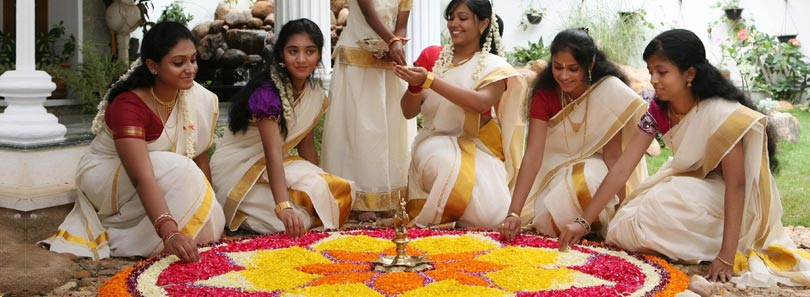Thrissur Pooram is the most spectacular festival of Kerala. It is aptly called Pooram of all Poorams where Pooram means 'the meeting point of all the arts'. Rich art and culture of the state of Kerala can be seen in all its splendor in this marathon 36 hours festival.
Thrissur Pooram is celebrated in the asterism Pooram in the month of Medam according to Malayalese calendar. This refers to the month of April-May according to Gregorian calendar. The festival was introduced by the erstwhile Maharaja of Kochi, Rama Varma. Celebrations are held at Thekkinkadu grounds encircling the Vadakunnathan temple. A large number of spectators and devotees assemble to watch the joyous festival which witnesses a meeting of deities of ten different temples. Procession of decorated elephants, dazzling display of fire works are the major attractions of the festival besides several other enthralling musical programmes and events.
Origin
Tradition of celebrating Thrissur Pooram as it is seen today was started by erstwhile Prince of Kochi (Cochin), Rama Varma also called Sakthan Thampuran (1775-1790). There is a little history to the festival which says that before Thrissur Pooram, a one-day temple festival was held at Aarattupuzha, 12 km south of the Thrissur. Temples located in and around Thrissur used to regularly participate in the ceremonies. All was going well until one day, chief of the Peruvanam area of Cherpu denied access to other temples to uphold the supremacy of Namboodiri. Namboodiris is the dominant brahmin caste in Kerala.
Prince Raja Varma, the architect of Thrissur, decided to put an end to Namboodiri supremacy and assuage the wounded confidence of his subjects. Rama Varma undertook the task of renovating Vadakunnathan temple, which was earlier bounded by high walls and was controlled by Namboodiris. He took on himself to look after the temple and made it open to all. He invited other temples with their deities to Thrissur to pay obeisance to Lord (Sri) Vakunnathan, the deity of the Vadakunnathan temple. The Prince also directed the main temples of Thrissur, Thiruvampadi and Pamamekkavu, which had never been under the control of Namboodiris to help other participating temples. It is said that the Prince also chalked the schedule of the 36 hours festival. The Pooram was thus made open to one and all. This also explains the secular nature of the festival. It is fascinating to note that Christians, Muslims and people of all castes participate with vigour and zeal in the Pooram.
Religious Programme
Following the ancient tradition, Thrissur Pooram is confined to the temples of Devi (goddess) and Sastha (divine combination of Shiva and Vishnu). Ten deities from the neighboring temples pay obeisance to the presiding deity of Thrissur. Chief participants are Paramekkavu and Tiruvambadi. Other participants called 'Cherupooram' include Kanimangalam, Karamukku, Choorakkattukara, Laloor, Ayyanthole, Neithilakkavu, Chembukkavu and Panamukkampilly.
The festival extends for 36 hours beginning with ezhunellippu of the Kanimangalam Shasta in the morning, followed by the ezhunnellippu of the other six minor temples on the Pooram Day. Where 'ezhunnellippu' is a ritual symbolising the visit of the Devi from the Paramekkavu and Thiruvambadi temples to the Vadakkunnathan temple. It may be noted that although this grand festival is known as Thrissur Pooram, it is in fact the conclusion of the eight-day Utsavams of nine temples.
Rituals and Celebrations
Major participants of the Pooram, Paramekkavu and Thiruvambadi provide a spectacular show of best of Kerala art and culture to the onlookers as they display their artistic prowess. The groups of artists vie with each to prove their mastery over their respective art and provide a rare show of talent to the spectators.
Massive and colourful processions are organised by temples, starting from Krishna Temple and Devi Temple. The groups enter the Vadakumnatha Temple through the western gate and take exit from the southern gate of the temple. This way they come face to face and the competition becomes open.
A major attraction of the festival is 'Panchavadyam'. Over 200 artistes from various disciplines like Thimila, Maddalam, Trumpet, Cymbal and Edakka unleash their talent and leave the audience spell bound. Time of noon is reserved for another event called, 'Pandemelam', in which artistes holding mastery of drum, trumpets, pipe and cymbal participate.
A procession of caparisoned elephants is the most enchanting facet of Thrissur Pooram. On the Pooram evening, two lines of 13 decorated elephants face each other, on the ground south to the temple. The best of elephants are selected for the procession and given a massive make over. They are painted, bejeweled and given a beautiful satin robe. Colourful silk parasols are the important parts of their get up. Each of the majestic pachyderm gets the honor of bearing an umbrella holder, a peacock fan carrier and a yak-tail fly whisk wielder. This exhibition of the paraphernalia of elephant decorative is called 'Aana Chamayal Pradarsanam'. Commissioning of elephants and the parasols is vital and is done with utmost secrecy as winning the competition is a matter of pride for the organisors.
Space between the two lines of elephants is taken up by the orchestra consisting of percussion and wind instruments. Just when the orchestra reaches its crescendo, the parasols are changed with an even more colourful and exquisite one. The ceremony is called, 'Kudamattom'. This is very exciting for the crowds who applaud whole heartedly every time the parasols change. The revelry continues till late in the evening. The deities of different temples arrive on the regally decorated elephants. The sight of the meeting of the different 'Gods' is brilliant and memorable one.
The festival concludes with the dazzling display of fire works. The bursting of crackers continues till the wee hours of the next morning. Shows by Thiruvambadi and Paramekkavu Devaswams are the most reputed and popular of all. Thus the festival which begins in the early hours of the Pooram morning concludes at the break of the dawn, the next day on a cheerful note.



